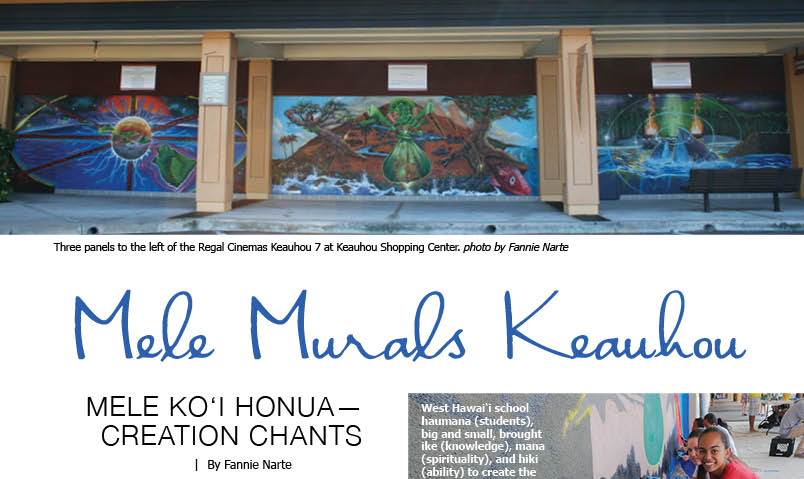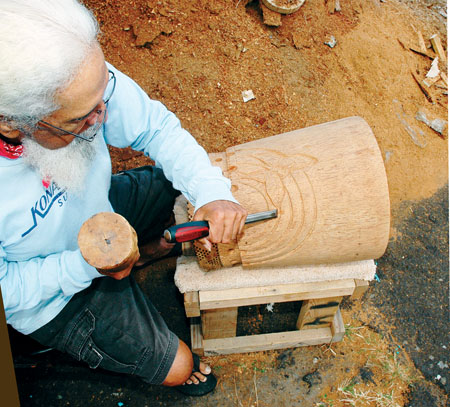
Crafting the Sacred Pahu Drum
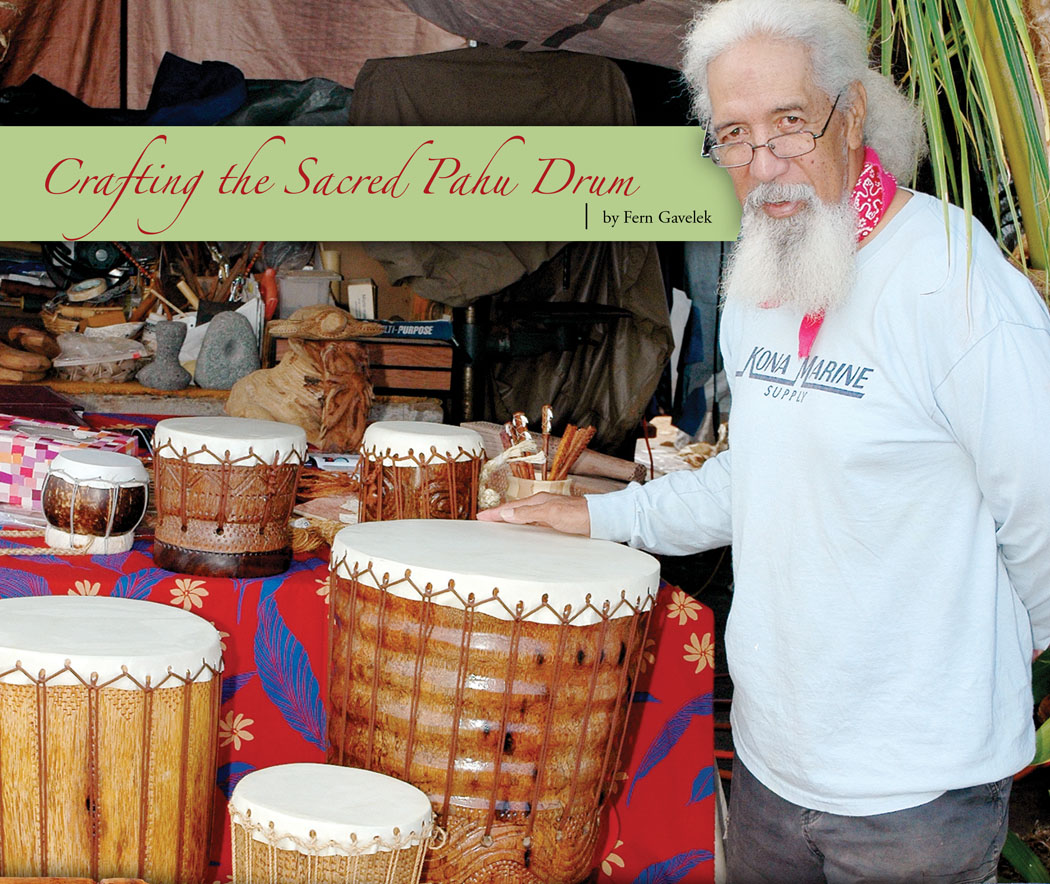 By Fern Gavelek
By Fern Gavelek
The drum selected him—not vise versa.
Kumu Hula Aloha Victor of Halau Kala‘akeakauikawekiu recalls when he purchased his first pahu (drum) from Rodney “Uncle Kala” Willis as if it were yesterday. It was October, 2005.
“We were having our first ho‘ike [show] and I forgot my pahu at home in Waikoloa,” he shares. “I didn’t have enough time to go back. In desperation, I prayed as I drove down to the King Kamehameha Kona Beach Hotel that Uncle Kala would be there. He was. I tested several drums and fell in love with the drum that selected me—not I selected the drum. She called to me and glowed in the light as if there were a spotlight on her.” Kumu Aloha says he named the drum “Naupaka,” for the beautiful carving of “half-shaped” flowers on the pahu’s base. “I appreciate all the extra work Uncle Kala puts into his drums,” he continues. “No two are alike.”
The Hawaiian pahu—which is made from a hollowed-out trunk and characterized by a very full and low sound—dates back to the stories of La‘amaikahiki, the son of the voyaging chief, Moikeha, who supposedly brought a pahu to Hawai‘i from Tahiti around 1200-1300 A.D. Kumu Hula Keala Ching, co-founder of Na Wai Iwi Ola Foundation, says the pahu was first used only at Hawaiian heiau. After the temples were destroyed, pahu went underground, kept by Hawaiian families, and “became part of each family’s tradition.”
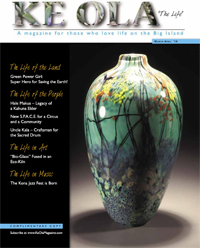
Today, hula halau accompany certain dances with pahu of different sizes. “Hula movements mimic nature,” describes Kumu Hula Micah Kamohoali‘i of Halau Na Ki Pu‘upu‘u. “The swish of the hips depicts the wind or ocean currents and the drum is said to be an echo of the heartbeat of Mother Earth. The drum entices the earth to interact with the dancer.”
Uncle Kala, a third generation la‘au (wood) artist, says these drums have long been sacred to Hawaiians. “We feel the maker of the drum puts his mana (spiritual power) into the drum,” he explains. He adds that drums are important in many cultures for signaling peace, love, healing, war and “to call people together.”
Uncle Kala carves an assortment of items—tapa beaters, nose flutes, traditional Hawaiian weapons and hair sticks—at his outdoor workshop on Hwy. 190 in mauka Keauhou. His business card, however, reads “Drums of Keauhou” as creating Hawaiian drums is a passion that has become Uncle Kala’s specialty.
“I do what I know,” says Uncle Kala, 64. “I’ve always been fascinated with drums. I love the sound.”
When growing up in Waikiki, Uncle Kala remembers watching his father and grandfather fashion souvenirs for tourists on Kalakaua Avenue. “They made jewelry, carved small canoes and small drums,” he recalls. “I would sit and watch, not touch anything. I helped sand, but my job was to gather nuts, seeds and shells.”
An interest in woodworking resurfaced in Uncle Kala’s life in 1994 after illness ended his tenure as a Kona school bus driver. He decided to help “pay the bills” by carving wood souvenirs. While making a turtle on a canoe, his work caught the eye of the late Bernard “Papa” Kimitete, a well-known Kona canoe builder and wood carver.
“Papa said he’d show me the tricks of carving wood and took me under his wing,” details Uncle Kala. “But he said I needed to be myself and I knew he was talking about me being myself as a Hawaiian.”

To that end, Uncle Kala carves what he thinks is appropriate on a drum. “All the trunks have a story or history, so I know what to do with them,” the master carver shares. “And sometime people request an image, but I won’t do just anything.” Case in point is a snake. “There are no snakes in Hawai‘i—eels yes, but no snakes,” he laughs.
As Uncle Kala works on a requested design of a rainbow and butterfly on a pahu, he defends the art, saying, “We sing and dance about rainbows and butterflies.” The artist also creates abstract designs by depicting things in nature, like shark teeth. “I always let the wood talk to me, especially when I’m carving,” he muses. “I often walk away from my work, particularly if it’s a face, to see the image differently.”
Niu (coconut) wood is the medium of choice for the pahu drum as it yields “a better sound.” Getting the wood to make the pahu is “half of the drum-making process.” People often phone Uncle Kala and his wife of nearly 50 years, Aunty Leikini, with offers of segmented tree trunks. Trees that have been felled for the right reasons—like storm damage or old age—are accepted. The wood that makes the best drums is from trees grown near the ocean, he says, as they grow more slowly and “do hula everyday in the breeze, so they are stronger.” As the tree ages, the wood also gets denser, which is preferred.
Wood is dried for about six months and protected from the sun to prevent cracking. A dousing of diesel fuel keeps the bugs out. Uncle Kala begins each drum with a pule (prayer) before taking off the bark and hollowing out the interior to form a resonance chamber. The bottom of the chamber acts like a sound reflector.
“The sound hits the bottom and comes back out,” Uncle Kala demonstrates, while tapping on a pahu.
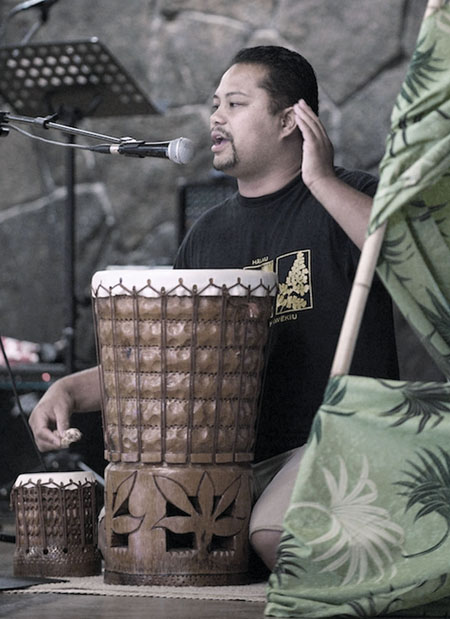
Ever since visiting the renowned Bishop Museum archives in the late 1990s, Uncle Kala has been shaping the insides of his drums in the Hawaiian way.
“I went to the museum to display my Hawaiian weapons and while there I saw all the Polynesian drums,” he recalls. “I noticed the Hawaiian drums had a round, rather than flat bottom inside, so I’ve been making drums that way ever since.”
To do this, Uncle Kala hollows out the top resonance chamber about two thirds of the way down and then flips the trunk upside down and chisels out a convex or bowl shape that is separated from the top chamber by a fibrous wood wall or septum. The septum divides the two evacuated sections.
The late Kumu Hula Master “Uncle” George Naope, who co-founded the Merrie Monarch Hula Festival, told Uncle Kala the septum was the drum’s piko (bellybutton) and without it, “a pahu isn’t a pahu.”
Uncle Kala puts a piece of koa on the exterior base of all his drums, saying it’s his “signature,” adding, “In Hawaiian, koa means ‘foundation, the pillar.’ ” The head of the drum is capped in cowhide, as it’s closest in feel to the sharkskin that was used by ancient Hawaiians. The skin is secured to the drum by nylon cordage. The artist finishes the pahu with a light epoxy to seal the wood, which is left in its natural color to “warm with age.”
The pahu at Drums of Keauhou come in different sizes. The larger, temple pahu are tall enough to play while standing, while the hula pahu run from 14 to 30 inches tall and are comfortably played kneeling. Also available is a puniu, a drum made from a hollow coconut shell that’s tied to the knee. Drums range in price from $25 to $2,500. They can be purchased at his workshop, which is open by appointment, 938.3192, or at the Outrigger Keauhou Beach Resort through the Huaka‘i cultural office, 324.2537.
Saying he’s always learning, Uncle Kala’s eyes shine when he talks about meeting carvers from New Zealand, Australia, Madagascar, Africa, Canada and the western U.S. at celebrations like the 2007 PIKO Gathering for Indigenous Artists. He shares his wood carving expertise as a teacher with the Hawaiian Ohana For Education in the Arts (HOEA), a three-year native Hawaiian pilot art project. [See article in Sept.-Oct. 2009 issue of Ke Ola.] Kumu Keala says plans are also in the works for Uncle Kala to teach an upcoming drummaking workshop.
While Uncle Kala says he’s taught about 40 students to make drums, he adds, “I have 10 grandchildren and I’m hopeful to be able to pass my knowledge on to one of them.” ❖
While Uncle Kala’s drums are sure to be gracing the Merrie Monarch stage April 7-10 in Hilo, you can also see them in action at upcoming Big Isle events:
- “Mauliauhonua-The Descendants” a hula drama about the legends and kuleana of the people of Waipio Valley, presented by Halau Na Ki Pu‘upu‘u at Honoka’a People’s Theatre 7-9 p.m. March 6. For info, email nakipuupuu@gmail.com.
- “Mama My Mama…I Love You…A Mother’s Day Celebration” presented by Hula Halau Kala‘akeakauikawekiu at the Sheraton Keauhou Bay Resort and Spa 5:30 p.m. May 8. For info, phone 989.4616 or visit www.halau-k.com.


